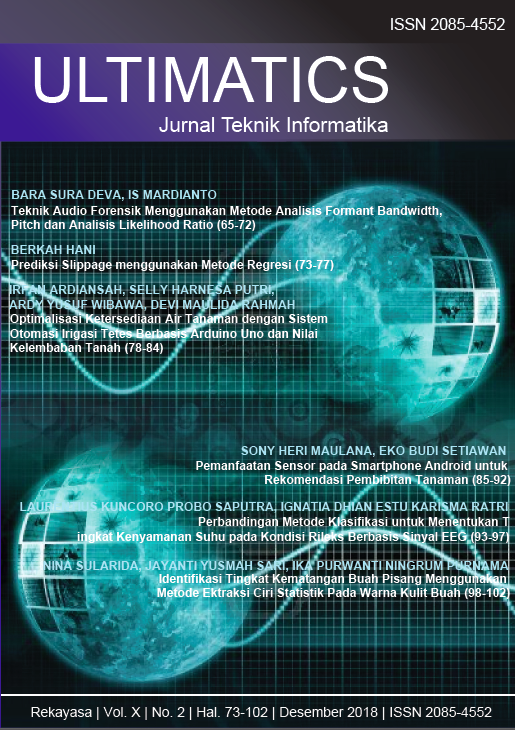Perbandingan Metode Klasifikasi untuk Menentukan Tingkat Kenyamanan Suhu pada Kondisi Rileks Berbasis Sinyal EEG
DOI:
https://doi.org/10.31937/ti.v10i2.992Abstract
Temperature control on air conditioner devices is still oriented to the target environment. This control mode ignores one's physiological condition. A person's thermal comfort varies when indoors. Thermal comfort is closely related to environmental thermal satisfaction conditions. EEG signal is a signal that can reflect brain activity. This research objective is provide classifier model for classifiying person's thermal comfort based on eeg signal. This research used three conditions of room's temperature. The features used by classfier are avarage frequency band, HFD, PFD, and MSE features. Classifier performance was assessed using ROC curve evaluation. The results of the classification of thermal comfort levels with EEG signals with the KNN classifier are obtained only by using the band frequency average feature, which is equal to 0.878 with a standard deviation of 0.022. While the SVM classifier gets the highest performance by using a combination of the average band + HFD frequency feature, which is 0.877 with a standard deviation of 0.013 in the linear kernel and RBF.
Downloads
Downloads
Published
How to Cite
Issue
Section
License
Authors retain copyright and grant the journal right of first publication with the work simultaneously licensed under a Creative Commons Attribution-ShareAlike International License (CC-BY-SA 4.0) that allows others to share the work with an acknowledgement of the work's authorship and initial publication in this journal.
Authors are able to enter into separate, additional contractual arrangements for the non-exclusive distribution of the journal's published version of the work (e.g., post it to an institutional repository or publish it in a book), with an acknowledgement of its initial publication in this journal.
Copyright without Restrictions
The journal allows the author(s) to hold the copyright without restrictions and will retain publishing rights without restrictions.
The submitted papers are assumed to contain no proprietary material unprotected by patent or patent application; responsibility for technical content and for protection of proprietary material rests solely with the author(s) and their organizations and is not the responsibility of the ULTIMATICS or its Editorial Staff. The main (first/corresponding) author is responsible for ensuring that the article has been seen and approved by all the other authors. It is the responsibility of the author to obtain all necessary copyright release permissions for the use of any copyrighted materials in the manuscript prior to the submission.















